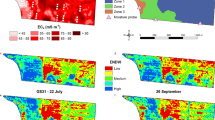Abstract
A classical soil line (SL) in the RED–NIR spectral space is specified by two coefficients “a” and “b.” In this form, it does not characterize soil types and subtypes. A multitemporal soil line (MSL) represents the major axis of the ellipse describing all possible pairs of RED–NIR values characterizing a bare soil surface for a given pixel of remote sensing images. The MSL in the RED–NIR spectral space is specified by several (N) coefficients. The resulting N-dimensional space of MSL coefficients makes it possible to give unique characteristics for each type and subtype of soils in the following zonal soil sequence: soddy-podzolic soils, light gray forest soils, gray forest soils, dark gray forest soils, podzolized chernozems, and leached chernozems. The analysis of variance allows us to state that the soils of this sequence significantly differ from one another in the characteristic sets of MSL coefficients. In other words, these coefficients characterize soil types and subtypes, and the MSL can be considered an empirical soil line (ESL) of the given type and subtype of soil. A classical SL is an integrity of ESLs of different soils within the given scene of remote sensing data.
Similar content being viewed by others
References
A. V. Bryzzhev, D. I. Rukhovich, P. V. Koroleva, N. V. Kalinina, E. V. Vil’chevskaya, E. A. Dolinina, and S. V. Rukhovich, “Organization of retrospective monitoring of the soil cover in Azov district of Rostov oblast,” Eurasian Soil Sci. 48, 1029–1049 (2015).
P. V. Koroleva, D. I. Rukhovich, A. D. Rukhovich, D. D. Rukhovich, A. L. Kulyanitsa, A. V. Trubnikov, N. V. Kalinina, and M. S. Simakova, “Location of Bare Soil Surface and Soil Line on the RED–NIR Spectral Plane,” Eurasian Soil Sci. 50, 1375–1385 (2017).
A. Kostikova, Atmospheric correction of Landsat/ETM+ data (COST method), GIS-Lab, 2006. http://gis-lab. info/qa/atcor.html.
A. Kostikova, Conversion of TM, ETM+ data to radiation indices on the sensor, GIS-Lab, 2004. http://gislab. info/qa/dn2radiance.html.
A. L. Kulyanitsa, P. V. Koroleva, D. I. Rukhovich, A. D. Rukhovich, D. D. Rukhovich, and M. S. Simakova, “Frequency of occurrence of bare soil surface as a quantitative parameter of the intensity of land use,” Inf. Kosmos, No. 1, 139–145 (2017).
A. L. Kulyanitsa, A. D. Rukhovich, D. D. Rukhovich, P. V. Koroleva, D. I. Rukhovich, and M. S. Simakova, “The application of the piecewise linear approximation to the spectral neighborhood of soil line for the analysis of the quality of normalization of remote sensing materials,” Eurasian Soil Sci. 50, 387–395 (2017).
D. I. Rukhovich, V. B. Wagner, E. V. Vil’chevskaya, N. V. Kalinina, and P. V. Koroleva, “Problems of using digitized thematic maps on the territory of the former soviet union upon the creation of the “Soils of Russia” geographic information system,” Eurasian Soil Sci. 44, 957–968 (2011).
D. I. Rukhovich, P. V. Koroleva, E. V. Vil’chevskaya, and N. V. Kalinina, “Digital thematic cartography as the shift of available sources and their use,” in Theoretical and Practical Studies in the Field of Digital Soil Mapping in Russia (Dokuchaev Soil Science Inst., Moscow, 2012), pp. 58–86.
D. I. Rukhovich, A. D. Rukhovich, D. D. Rukhovich, E. V. Vil’chevskaya, G. A. Suleiman, and N. V. Kalinina, “Application of soil line for creating the maps of averaged spectral deviations and their soil interpretation,” Inf. Kosmos 5 (3), 125–142 (2015).
D. I. Rukhovich, A. D. Rukhovich, D. D. Rukhovich, M. S. Simakova, A. L. Kulyanitsa, A. V. Bryzzhev, and P. V. Koroleva, “The informativeness of coefficients a and b of the soil line for the analysis of remote sensing materials,” Eurasian Soil Sci. 49, 831–845 (2016).
D. I. Rukhovich, A. D. Rukhovich, D. D. Rukhovich, M. S. Simakova, A. L. Kulyanitsa, A. V. Bryzzhev, and P. V. Koroleva, “Maps of averaged spectral deviations from soil lines and their comparison with traditional soil maps,” Eurasian Soil Sci. 49, 739–756 (2016).
D. I. Rukhovich, M. S. Simakova, A. L. Kulyanitsa, A. V. Bryzzhev, N. V. Kalinina, P. V. Koroleva, E. V. Vil’chevskaya, E. A. Dolinina, and S. V. Rukhovich, “Analysis of the application of soil maps for retrospective monitoring of the soil cover,” Pochvovedenie., No. 5, 605–625 (2015).
R. J. Kauth and G. S. Thomas, “The tasseled cap—a graphic description of the spectral-temporal development of agricultural crops as seen by Landsat,” Proceedings of the Symposium on Machine Processing of Remotely Sensed Data (Purdue University of West Lafayette, West Lafayette, 1976), pp. 4B-41–4B-51
F. J. Kriegler, W. A. Malila, R. F. Nalepka, and W. Richardson, “Preprocessing transformations and their effects on multispectral recognition,” Proceedings of the Sixth International Symposium on Remote Sensing of Environment (University of Michigan, Ann Arbo, 1969), pp. 97–131.
J. Qi, Y. Kerr, and A. Chehbouni, “External factor consideration in vegetation index development,” Proceedings of Sixth International Symposium “Physical Measurements and Signatures in Remote Sensing” (Val d'Isère, 1994), pp. 723–730.
A. J. Richardson and C. L. Wiegand, “Distinguishing vegetation from soil background information,” Photogramm. Eng. Remote Sens. 43, 1541–1552 (1977).
J. W. Rouse, R. H. Haas, J. A. Schell, and D. W. Deering, “Monitoring vegetation systems in the great plains with ERTS,” Proceedings of Third Earth Resources Technology Satellite-1 Symposium (National Aeronautics and Space Administration, Washington, 1973), Vol. 1, pp. 309–317.
A. D. Rukhovich, D. D. Rukhovich, and D. I. Rukhovich, “Applying the elastic map method to analyze three-dimensional distribution of the soil line coefficients,” Proceedings International Conference “Global Soil Map 2017,” Moscow, Russia, July 4–6, 2017 (Dokuchaev Soil Science Institute, Moscow, 2017), p. 75.
Author information
Authors and Affiliations
Corresponding author
Additional information
Original Russian Text © P.V. Koroleva, D.I. Rukhovich, A.D. Rukhovich, D.D. Rukhovich, A.L. Kulyanitsa, A.V. Trubnikov, N.V. Kalinina, M.S. Simakova, 2018, published in Pochvovedenie, 2018, No. 9, pp. 1085–1098.
Rights and permissions
About this article
Cite this article
Koroleva, P.V., Rukhovich, D.I., Rukhovich, A.D. et al. Characterization of Soil Types and Subtypes in N-Dimensional Space of Multitemporal (Empirical) Soil Line. Eurasian Soil Sc. 51, 1021–1033 (2018). https://doi.org/10.1134/S1064229318090065
Received:
Published:
Issue Date:
DOI: https://doi.org/10.1134/S1064229318090065




